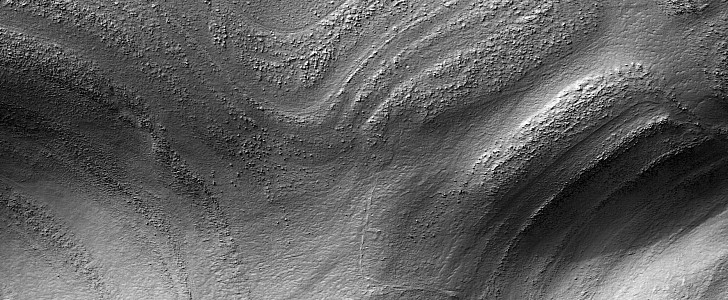It might be a bit difficult, but try imagining Mars with vast oceans and raging rivers, and why not, perhaps even touches of green vegetation from place to place. If somehow you can place that image into your head, hold on to it, as it is nothing but a glimpse into the history of the planet.
Without actually going there in person, we humans have slowly become convinced Mars was once not unlike Earth, and possibly even a haven for life of some kind. It’s dead now, of course, but the signs of its glorious past are still there, provided one knows where to look and, more importantly, knows how to interpret what they're seeing.
If you were to ask us, the image used as the main pic of this piece looks pretty boring and pretty much in tone with everywhere else that can be found on Mars at the moment. But to the scientists from NASA and the University of Arizona, it is yet another possible proof of large bodies of water once being present on the surface.
Taken by the HiRISE camera back in 2010 from an altitude of 259 km (161 miles), it shows a small portion (5 km/3 miles across) of the Hellas Planitia region, an area known as Alpheus Colles.
This region, NASA says, “is characterized by highly deformed layered sediment nicknamed honeycomb or taffy pull terrain.” Scientists do not fully understand the origins of this type of sedimentation, “but it may be related to an ancient lake or ocean in Hellas.”
By all accounts, the region where this feature can be found, Hellas Planitia, is one of the largest impact craters we humans are aware of anywhere in this Universe, coming in with a diameter of 1,400 miles (2,253 km), and in places going 9,800 feet (3 km) deep.
If you were to ask us, the image used as the main pic of this piece looks pretty boring and pretty much in tone with everywhere else that can be found on Mars at the moment. But to the scientists from NASA and the University of Arizona, it is yet another possible proof of large bodies of water once being present on the surface.
Taken by the HiRISE camera back in 2010 from an altitude of 259 km (161 miles), it shows a small portion (5 km/3 miles across) of the Hellas Planitia region, an area known as Alpheus Colles.
This region, NASA says, “is characterized by highly deformed layered sediment nicknamed honeycomb or taffy pull terrain.” Scientists do not fully understand the origins of this type of sedimentation, “but it may be related to an ancient lake or ocean in Hellas.”
By all accounts, the region where this feature can be found, Hellas Planitia, is one of the largest impact craters we humans are aware of anywhere in this Universe, coming in with a diameter of 1,400 miles (2,253 km), and in places going 9,800 feet (3 km) deep.






